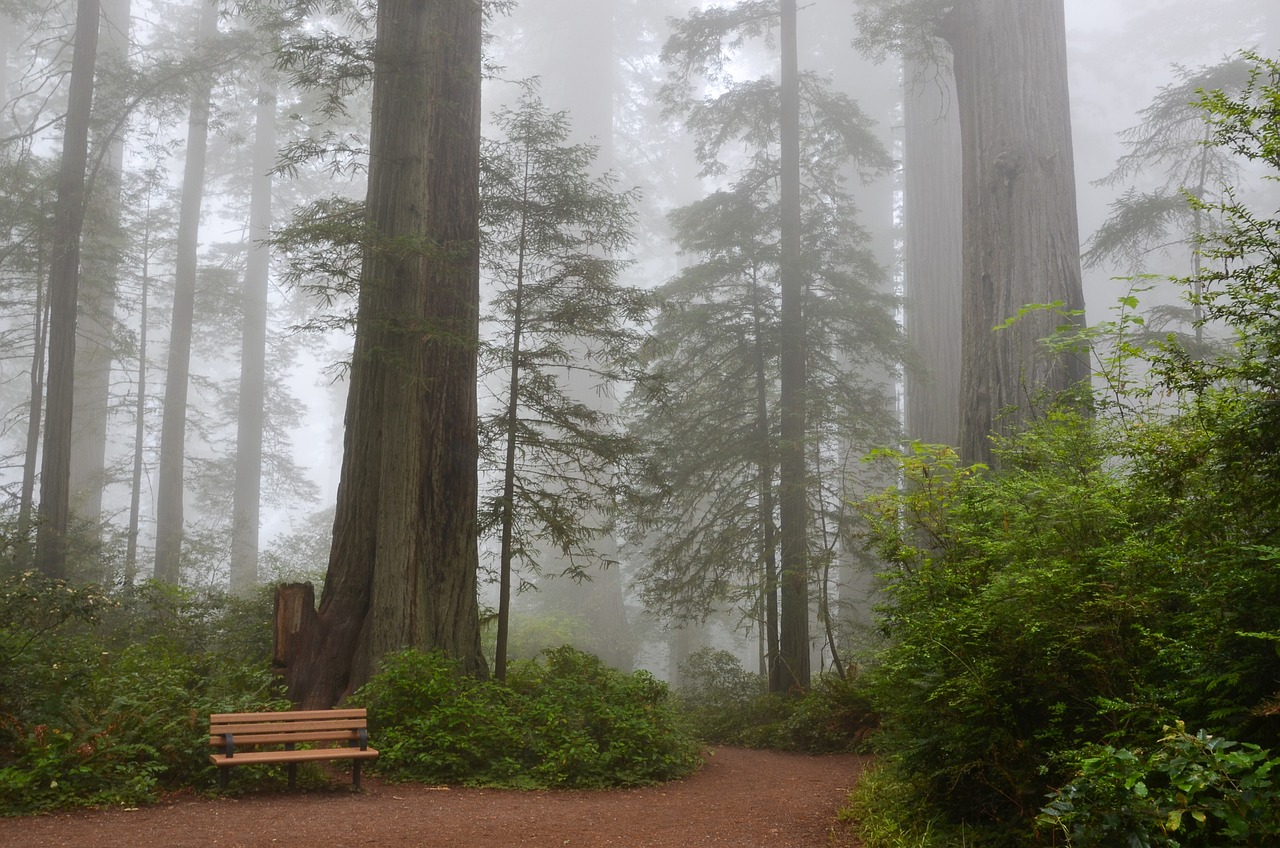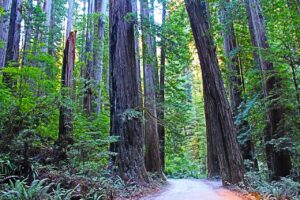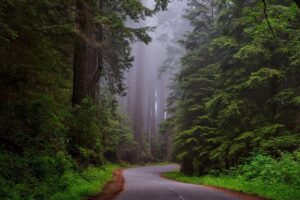Redwood
Overview
The Redwood, or Sequoia sempervirens, stands as a botanical giant with a rich history. This evergreen member of the Cupressaceae family, reaching up to 360 feet tall, figures prominently on the western landscape, often flanked by ferns and hemlocks4. While not noted for medicinal or culinary uses, it’s greatly admired as an ornamental tree. Its ability to reach ancient ages, between 1,200 and 2,200 years, adds to its historical mystique and biological wonder4.

Characteristics
Known for its towering height, remarkable longevity, and cohabitation with a diversity of understory flora.
Region
Thrives in the western United States, particularly in coastal California and Oregon.
Natural Habitat
The Redwood plant is usually found in coastal forests in the western United States.
Cultivation
Prefers full sun to partial shade, ample moisture, and well-drained, acidic soil rich in organic matter.
Uses and Benefits
While the Redwood herb may not have direct culinary or medicinal applications, its allure lies in the majestic beauty of the Redwood tree (Sequoia sempervirens). These towering giants can reach astonishing heights of up to 360 feet, making them a true marvel of nature2.
The dawn redwood, a relative of the Redwood tree, has found its place as a beloved ornamental plant. Its striking presence graces temperate landscapes, adding a touch of grandeur to gardens and parks5.
Picture yourself on a walk through a Redwood forest, surrounded by these ancient giants. At your feet, you’ll find a diverse array of companion plants, such as:
- Ferns
- Redwood sorrel
The coexistence of these species is a testament to the Redwood’s ability to foster a thriving ecosystem4.
Although not a traditional herb, the Redwood tree enriches our lives with its awe-inspiring presence and the serene environment it creates. Simply being in the presence of these ancient wonders can be a transformative experience.

Cultivation Tips
Growing your own Redwood tree can be a rewarding venture, considering these mighty trees can soar to remarkable heights at a rate of up to six feet each year1. To maximize their potential, follow these cultivation tips:
- Choose the right location: Redwoods prefer the cooler, moist climate of western regions, where they flourish alongside diverse companions like the western hemlock. Ensure your chosen spot mimics their natural environment.
- Provide ample space: Redwoods require plenty of room to grow, both above and below ground. Make sure to plant them in an area with sufficient space for their expansive root systems and towering canopies.
- Maintain consistent moisture: These trees thrive in moist soil conditions. Water your Redwood regularly, especially during dry spells, to keep the soil evenly moist but not waterlogged.
- Ensure rich, well-draining soil: Redwoods grow best in nutrient-rich soil that allows for proper drainage. Amend your soil with organic matter, such as compost or well-rotted manure, to improve its structure and fertility.
- Protect young trees: While established Redwoods are resilient, young trees may need protection from strong winds, frost, and browsing animals. Consider using stakes, tree shelters, or fencing to support and safeguard your sapling.
As evergreens, Redwoods will impress with year-round foliage, making a stunning, enduring addition to any landscape. Remember, patience is key; Redwoods are an investment in the future, growing stronger and taller for centuries4.
Seasonal Considerations
When growing your own Redwood tree, it’s essential to consider the changing seasons and how they impact this majestic evergreen. While Redwoods will grace your landscape with lush, green foliage year-round, they do experience seasonal changes that affect their growth and care requirements.
In the spring and summer months, Redwoods thrive on ample moisture and cooler temperatures. Ensure your tree receives consistent watering during this time, especially if rainfall is scarce. Applying a layer of organic mulch around the base of the tree will help retain soil moisture and regulate temperature fluctuations.
As autumn arrives, Redwoods will continue to grow, albeit at a slower pace. While they don’t display the vibrant color changes associated with deciduous trees, you may notice some needle shedding as the tree prepares for winter. This is a normal process and shouldn’t cause concern.
During the winter months, Redwoods demonstrate their adaptability and resilience. They are well-equipped to handle cooler temperatures and even occasional snowfall in their native range. However, if you live in an area with severe winter conditions, it’s crucial to protect younger Redwood trees with insulating materials like burlap or mulch to prevent damage from freezing temperatures and drying winds.
Throughout the seasons, monitor your Redwood for any signs of stress, such as yellowing needles or stunted growth. These may indicate a need for adjustments in watering, fertilization, or other care practices. By remaining attentive to your tree’s needs and the changing seasons, you’ll create an environment where your Redwood can thrive for generations to come1.

Issues and Troubleshooting
The mighty Redwood, while resilient and long-living, can face challenges. With their preference for the cooler, moist climates of the western regions, they might struggle in drier or polluted conditions which can lead to stress and increased susceptibility to disease. These giants also face the threat of deforestation, which not only reduces their numbers but also disturbs the delicate ecosystem they support. It’s essential to protect these ancient beings by ensuring that they have the right environment to flourish, including adequate water, soil conditions, and protection from excessive logging4. Redwoods stand as a testament to nature’s grandeur, and their care is a reflection of our commitment to preserving natural history.
History and Folklore
Redwood trees have been woven deeply into the fabric of folklore and revered in many cultures as symbols of ancient wisdom and endurance. While these magnificent trees were first scientifically acknowledged in the 19th century, their true legacy stretches far back into the mists of time. It is likely that the indigenous peoples of the Americas observed these giants in awe long before European naturalists penned their findings3.
The botanical world was shaken by the rediscovery of the dawn redwood (Metasequoia glyptostroboides), a relative of the coast redwood. This species was believed to be extinct and only known from fossil records, but its return to the living realm reads like a fairy tale of nature’s resilience5. The story of the dawn redwood’s rediscovery is a testament to the enduring mystery and wonder of the natural world.
To this day, the majestic redwood trees continue to capture human imagination, symbolizing:
- Longevity and the ability to stand the test of time
- An unbroken connection to Earth’s primordial past
- The resilience and adaptability of life in the face of change
The history and folklore surrounding redwood trees serve as a reminder of the deep, intrinsic bond between humans and nature, and the importance of preserving these ancient wonders for generations to come.
References
1. Gardening Know How. “Redwood Tree Information – Interesting Facts About Redwood Trees.” https://www.gardeningknowhow.com/ornamental/trees/redwood/redwood-tree-information.htm
2. Leafy Place. “Redwood Trees: Types, Facts and Identification (With Pictures).” https://leafyplace.com/redwood-trees/
3. Treehugger. “Understanding redwood history and biology.” https://www.treehugger.com/the-essential-redwood-tree-4066094
4. Wikipedia. “Sequoia sempervirens.” https://en.wikipedia.org/wiki/Sequoia_sempervirens
5. Wikipedia. “Metasequoia glyptostroboides.” https://en.wikipedia.org/wiki/Metasequoia_glyptostroboides
https://pixabay.com/photos/usa-america-california-sequoias-1669714/
https://pixabay.com/photos/redwood-national-park-california-usa-2138582/
https://pixabay.com/photos/trees-fog-street-road-lane-lush-1587301/
Nicolas Duval
Nicolas is a passionate advocate for nature and the art of wildcrafting. His dedication shines through in Wildcraftia, a website he meticulously crafted to serve as a haven for nature enthusiasts worldwide. Driven by a deep appreciation for nature’s connection to humanity, Nicolas embarked on his journey in 2011 with SmokableHerbs, a platform showcasing his love for nature’s bounty. Building upon this foundation, he established Smokably, a thriving online store offering premium herbs and blends to a global audience.
